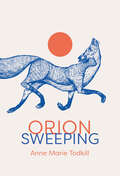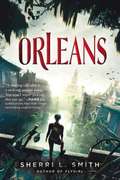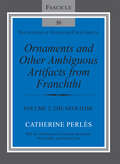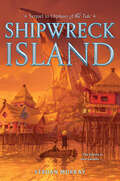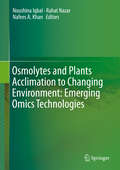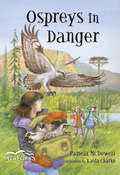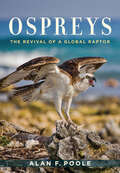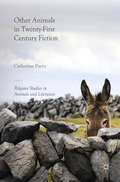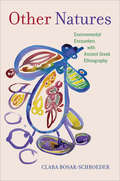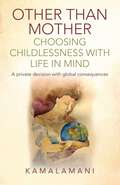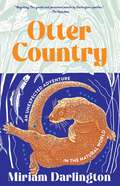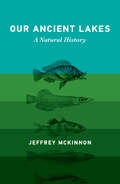- Table View
- List View
Origins: The Cosmos in Verse
by Joseph ConlonA poetic odyssey through the origins of the universe from one of Britain&’s leading physicists.There raged a thumping cosmic ballyhoo, A manic dance – a rumpus to arouse The universe: of Higgs and W, Electrons, gluons, muons, Zs and taus… For centuries poetry and science have been improbable, yet constant, bedfellows. Chaucer was an amateur astronomer; Milton broke bread with Galileo; and, before turning to the arts, Keats was a doctor. Meanwhile, scientific luminaries like Ada Lovelace and James Clerk Maxwell moonlighted as poets, composing verse between experiments and equations. Following in this tradition, theoretical physicist Joseph Conlon spins a dazzling intergalactic epic. Drawing on his scientific expertise, Conlon reveals the origins of our universe through two long-form poems – &‘Elements&’ and &‘Galaxies&’. Journeying from the Big Bang to the edges of our ever-expanding cosmos, Origins offers a delightful and revelatory adventure through contemporary physics.
Oriole Book
by Nancy Flood• Illustrated natural history information on a popular backyard visitor, covering feeding behaviors, courtship, nest building, raising young, migration, and more• Focus on Baltimore and Bullock's Orioles but with information on every North American species• How to make your yard or garden more attractive to oriolesThe brilliant flash of an oriole's orange or yellow plumage against a black background is a welcome sign of spring for birders and backyard bird-watchers alike. Learn more about one of the most colorful and popular groups of birds in North America with this fact-filled guide.
Orion Sweeping
by Anne Marie TodkillAnne Marie Todkill's debut recalibrates the anxiety of the present. It gives doubt a hearing, finding resilience in fragility and grace in unexpected places. The poems assembled in Orion Sweeping take nothing at face value. What are we to make of a radioactive souvenir, a shape-shifting dog, landscapes made strange by time? The speakers gathered here seek to set the record straight: a mink gives advice; a wolf disputes a rumour; a photographer zooms in on a kill; a military strategist gives lessons in peace. But the sum of the evidence is not bleak. A baby arrives as robustly as a whale; the solidarity of marriage is enacted in surprising ways; father and daughter share a gift for reprieve. Under the penetrating gaze of these poems, beauty and tenderness come quietly into view.
Orleans
by Sherri L. SmithFirst came the storms. Then came the Fever. And the Wall. After a string of devastating hurricanes and a severe outbreak of Delta Fever, the Gulf Coast has been quarantined. Years later, residents of the Outer States are under the assumption that life in the Delta is all but extinct…but in reality, a new primitive society has been born. Fen de la Guerre is living with the O-Positive blood tribe in the Delta when they are ambushed. Left with her tribe leader’s newborn, Fen is determined to get the baby to a better life over the wall before her blood becomes tainted. Fen meets Daniel, a scientist from the Outer States who has snuck into the Delta illegally. Brought together by chance, kept together by danger, Fen and Daniel navigate the wasteland of Orleans. In the end, they are each other’s last hope for survival. Sherri L. Smith delivers an expertly crafted story about a fierce heroine whose powerful voice and firm determination will stay with you long after you’ve turned the last page. .
Orleans
by Sherri L. SmithFirst came the storms.Then came the Fever. And the Wall. After a string of devastating hurricanes and a severe outbreak of Delta Fever, the Gulf Coast has been quarantined. Years later, residents of the Outer States are under the assumption that life in the Delta is all but extinct...but in reality, a new primitive society has been born. Fen de la Guerre is living with the O-Positive blood tribe in the Delta when they are ambushed. Left with her tribe leader's newborn, Fen is determined to get the baby to a better life over the wall before her blood becomes tainted. Fen meets Daniel, a scientist from the Outer States who has snuck into the Delta illegally. Brought together by chance, kept together by danger, Fen and Daniel navigate the wasteland of Orleans. In the end, they are each other's last hope for survival. Sherri L. Smith delivers an expertly crafted story about a fierce heroine whose powerful voice and firm determination will stay with you long after you've turned the last page.
Ornaments and Other Ambiguous Artifacts from Franchthi: Volume 2, The Neolithic (Excavations at Franchthi Cave, Greece)
by Catherine PerlèsThe famous Franchthi Cave excavations in Greece brought to light an exceptionally long sequence of ornaments, spanning from the earliest Upper Paleolithic to the end of the Neolithic. This volume focuses on the Neolithic, whose assemblages are far more diversified than those of earlier times. The introduction during the Neolithic of entirely artificial shapes, geometric and anthropomorphic, creates a marked departure from earlier periods and shows new directions in creativity by the bead makers. It also denotes a conceptual break in the treatment of shell, no longer solely a natural element barely modified by perforation, but now also a raw material rendered anonymous by workmanship. Due to the systematic sieving of the sediments and its location by the sea, the Franchthi cave and its outdoor settlement, the Paralia, yielded one of the richest collection of ornaments for Neolithic Greece.
Orphan Crops for Sustainable Food and Nutrition Security: Promoting Neglected and Underutilized Species (Issues in Agricultural Biodiversity)
by Danny Hunter Stefano Padulosi E.D. Israel Oliver King M. S. SwaminathanOrphan Crops for Sustainable Food and Nutrition Security discusses the issues, challenges, needs and opportunities related to the promotion of orphan crops, known also as neglected and underutilized species (NUS). The book is structured into six parts, covering the following themes: introduction to NUS, approaches, methods and tools for the use enhancement of NUS, integrated conservation and use of minor millets, nutritional and food security roles of minor millets, stakeholders and global champions, and, building an enabling environment. Presenting a number of case studies at the regional and country levels, the chapters cover different but highly interlinked aspects along the value chains, from acquisition and characterization of genetic diversity, cultivation and harvesting to value addition, marketing, consumption and policy for mainstreaming. Cross-cutting issues like gender, capacity building and empowerment of vulnerable groups are also addressed by authors. Representatives from communities, research for development agencies and the private sector also share their reflections on the needs for the use enhancement of NUS from their own perspectives. This book will be of great interest to students and scholars of food security, sustainable agriculture, nutrition and health and development, as well as practitioners and policymakers involved in building more resilient food and production systems.
Orphans of the Tide #2: Shipwreck Island (Orphans of the Tide #2)
by Struan MurrayLoyalties are tested in this sequel to Orphans of the Tide, a smart, unique middle grade read perfect for fans of Wildwood or The Invention of Hugo Cabret.Ellie and Seth know more than most people do about living amongst gods. Ellie, an inventor with a tragic past, was once forced to become the human Vessel for the most wicked god of all, the Enemy; Seth, a mysterious boy with no memories, has just discovered that he’s actually a god himself.So when they escape the City and all of its inhabitants who want them dead, they hope to find a new island—free of gods—to call home.Months on a homemade raft have stretched their patience with each other, but at last they spot land—and when they arrive, it seems like every bit the paradise they’d been dreaming of.But the tropical island has its secrets just as the City did, and Ellie and Seth are faced with impossible questions about who they can trust and who they can’t—including each other.
Orphans of the Tide (Orphans of the Tide #1)
by Struan MurrayAn ancient myth looms over a powerful new friendship in this debut middle grade fantasy packed with Hugo Cabret charm.The City is the only home that Ellie has ever known. She’s always been told that there is nothing to see beyond the shores of her small, salty island.That is, until a mysterious boy washes in with the tide, trapped inside the belly of a whale.The citizens of the City believe he’s ruled by the Enemy—the legendary god who drowned the whole world—come again to cause untold chaos. Only Ellie believes that the boy is innocent.To save him, Ellie must prove that he’s not who they think he is—even if that means revealing her own dangerous secret.Fans of Wildwood and The Mysterious Benedict Society will be enthralled by this inventive and adventurous take on a modern classic.
Orwell's Roses
by Rebecca Solnit&“An exhilarating romp through Orwell&’s life and times and also through the life and times of roses.&” —Margaret Atwood &“A captivating account of Orwell as gardener, lover, parent, and endlessly curious thinker.&” —Claire Messud, Harper's&“Nobody who reads it will ever think of Nineteen Eighty-Four in quite the same way.&”—Vogue A lush exploration of roses, pleasure, and politics, and a fresh take on George Orwell as an avid gardener whose political writing was grounded in his passion for the natural world&“In the year 1936 a writer planted roses.&” So begins Rebecca Solnit&’s new book, a reflection on George Orwell&’s passionate gardening and the way that his involvement with plants, particularly flowers, and the natural world illuminates his other commitments as a writer and antifascist, and the intertwined politics of nature and power. Sparked by her unexpected encounter with the surviving roses he planted in 1936, Solnit&’s account of this understudied aspect of Orwell&’s life explores his writing and his actions—from going deep into the coal mines of England, fighting in the Spanish Civil War, critiquing Stalin when much of the international left still supported him (and then critiquing that left), to his analysis of the relationship between lies and authoritarianism. Through Solnit&’s celebrated ability to draw unexpected connections, readers encounter the photographer Tina Modotti&’s roses and her Stalinism, Stalin&’s obsession with forcing lemons to grow in impossibly cold conditions, Orwell&’s slave-owning ancestors in Jamaica, Jamaica Kincaid&’s critique of colonialism and imperialism in the flower garden, and the brutal rose industry in Colombia that supplies the American market. The book draws to a close with a rereading of Nineteen Eighty-Four that completes her portrait of a more hopeful Orwell, as well as a reflection on pleasure, beauty, and joy as acts of resistance.
Osha Laboratory Standard - Implementation Guide
by Richard EnnisThis manual contains four major components: 1) An easy-to-follow discussion of the Standard's requirements, along with a plan for implementing management responsibilities; 2) A fill-in schedule for assigning key responsibilities and establishing deadlines; 3) A copy of the OSHA Lab Standard for easy reference; 4) A Chemical Hygiene Plan that has been developed in accordance with the requirements of paragraph (e) of the Standard.
Osmolytes and Plants Acclimation to Changing Environment: Emerging Omics Technologies
by Nafees A. Khan Noushina Iqbal Rahat NazarThe continual change in climatic conditions induces a series of adaptations in plants to suit the unfavorable conditions for sustainable agriculture. For sustainable agriculture, it is important to unravel the precise mechanism(s) that disturb the homeostatic equilibrium at cellular and molecular level and also to enhance understanding to build strategies for the tolerance of plants. Osmolytes have long been identified as pivotal abiotic stress busters because of their role in plants in overcoming extremely harsh environmental conditions. This edited compilation attempts to put forth the scattered knowledge on osmolytes and their role in abiotic stress tolerance together and disseminate as a package to deal with the problems of lower productivity under stressful environment. It will enhance the understanding on osmolytes function and bioengineering of plants for abiotic stress tolerance. The book covers very interesting topics dealing with various osmolytes and the mechanistic approach for abiotic stress tolerance to pave the path of agricultural scientists, breeders for developing high yielding sustainable transgenic crops.
Ospreys in Danger (Orca Echoes)
by Pamela McDowellJenna "Cricket" McKay, protector of wildlife, stars in her first adventure! When an osprey nest atop an electrical pole catches fire, the whole town of Waterton loses power. Being a park warden’s daughter, Jenna (whom everyone calls Cricket) is there at the scene, where she finds three abandoned baby ospreys. Caring for the chicks proves to be challenging for Cricket. The birds are noisy, hungry and very picky eaters. But when she discovers that the power company is building a new anti-nesting device on the electrical pole, Cricket has an even bigger problem. How will she reunite the baby birds with their parents without a place for them to build a nest? The epub edition of this title is fully accessible.
Ospreys: The Revival of a Global Raptor
by Alan F. PooleA fascinating look at one of the greatest conservation success stories of the modern era: the wildly popular, unique, and thrilling raptor, the Osprey.Ospreys are one of the few bird species that are found throughout the world. From forests in Hokkaido to rivers in Oregon and islands off Australia, Ospreys steal the show as nature lovers easily watch them build their massive nests and tend to their young. The fact that the Osprey is one of the few large birds that can hover adds to its mystique, and to watch it plunge into the water, emerging with a fish clutched in its talons, is truly a sight one will remember. As widespread as Ospreys are, not long ago they were under threat of extinction. During the 1950s and '60s, scientists tied the decline of Osprey populations to the heavy use of DDT and other human pollutants. In the 1980s, Ospreys began a slow recovery due to the efforts of conservationists and through the resilience of the adaptable raptors themselves. Today they are again considered common in most parts of the world, although some populations remain threatened.In this gorgeously illustrated book, Alan F. Poole, one of America's premier Osprey experts, has written a lyrical exposé of these majestic creatures, describing their daily habits and exploring their relationship with the environment. Ospreys celebrates the species' miraculous recovery from contaminants and hunters, chronicles their spectacular long-distance migrations, and unveils their vital role in bringing life to coastal habitats. Few other birds have such a hold on the human imagination. This book shows us why.
Ostriches (Superpower Field Guide)
by Rachel PoliquinThis third installment in the hilarious and highly-illustrated full-color Superpower Field Guide series features the silly-looking, surprisingly fierce Ostrich. This two-toed torpedo may have the largest eyes of any animal on dry land, but it can outrun most horses! Meet Eno, an ordinary ostrich living in the Serengeti, a corner of the African savanna. But there's something you should know: Even ordinary ostriches are extraordinary. And that includes Eno. I know what you&’re thinking. You&’re thinking that ostriches are just overgrown chickens with ridiculous necks, skinny legs, and bad attitudes. And you&’re right! Believe it or not, that neck helps ostriches run at supersonic speeds. Those skinny legs can kill a lion dead. And these are only a few weapons in Eno's arsenal of superfierce survival skills—Eno has Colossal Orbs of Telescopic Vision, the Impossible Ever-Flow Lung, the Egg of Wonder, and so many more. You&’re still not convinced that ostriches are superpowered, are you? Well, you don&’t know ostriches yet. But you will.
Other Animals in Twenty-First Century Fiction
by Catherine ParryThis book is about ordinary animals and how they are imagined in twenty-first century fiction. Examining contemporary animal representations and the fraught and potent distinctions humans fashion between themselves and all other animals, it asks how a range of novels make, re-make or un-make traditional conceptions of the creatures we love, admire, eat, vilify and abuse. Other Animals' detailed readings of horses, an animalised human, a donkey, ants, chickens and chimpanzees develop new critical practices in Literary Animal Studies. They explore the connections between fictional animal representation, narrative form, ethics, and the lives and warm bodies of the real-world creatures that precede and exceed our imagination. Human-animal relationships are conditioned by our imaginative shapings of other animals, and by our sense of distinction from them, and Other Animals opens out how fictional animal forms and tropes respond to, participate in, or challenge the ways animals' lives are lived out in consequence of human imaginings of them.
Other Days
by John HainesSELECTIONS FROM A WORK IN PROGRESS: ESSAYS BY John Haines ILLUSTRATIONS BY Jo HAINES
Other Natures: Environmental Encounters with Ancient Greek Ethnography
by Clara Bosak-SchroederAncient Greek ethnographies—descriptions of other peoples—provide unique resources for understanding ancient environmental thought and assumptions, as well as anxieties, about how humans relate to nature as a whole. In Other Natures, Clara Bosak-Schroeder examines the works of seminal authors such as Herodotus and Diodorus Siculus to persuasively demonstrate how non-Greek communities affected and were in turn deeply affected by their local animals, plants, climate, and landscape. She shows that these authors used ethnographies of non-Greek peoples to explore, question, and challenge how Greeks ate, procreated, nurtured, collaborated, accumulated, and consumed. In recuperating this important strain of ancient thought, Bosak-Schroeder makes it newly relevant to vital questions and ideas being posed in the environmental humanities today, arguing that human life and well-being are inextricable from the life and well-being of the nonhuman world. By turning to such ancient ethnographies, we can uncover important models for confronting environmental crisis.
Other Than Mother - Choosing Childlessness with Life in Mind: A Private Decision With Global Consequences
by KamalamaniChoosing to have children is a private decision with global consequences. Other Than Mother explores the decision-making process around not having children. It is in three parts: Part I The Worldly Winds explores the backdrop to deciding whether or not to have children, including the cultural changes brought about by a rise in voluntary/intentional childlessness. Part II A Private Decision with Global Consequences explores the pros and cons in the decision-making process, including ecological and environmental considerations. Part III New Horizons and Baby-sized Projects explores living with the decision.
Otherlands: A Journey Through Earth's Extinct Worlds
by Thomas HallidayThe past is past, but it does leave clues, and Thomas Halliday has used cutting-edge science to decipher them more completely than ever before. In Otherlands, Halliday makes sixteen fossil sites burst to life on the page. <p><p> This book is an exploration of the Earth as it used to exist, the changes that have occurred during its history, and the ways that life has found to adapt―or not. It takes us from the savannahs of Pliocene Kenya to watch a python chase a group of australopithecines into an acacia tree; to a cliff overlooking the salt pans of the empty basin of what will be the Mediterranean Sea just as water from the Miocene Atlantic Ocean spills in; into the tropical forests of Eocene Antarctica; and under the shallow pools of Ediacaran Australia, where we glimpse the first microbial life. <p><p> Otherlands also offers us a vast perspective on the current state of the planet. The thought that something as vast as the Great Barrier Reef, for example, with all its vibrant diversity, might one day soon be gone sounds improbable. But the fossil record shows us that this sort of wholesale change is not only possible but has repeatedly happened throughout Earth history. Even as he operates on this broad canvas, Halliday brings us up close to the intricate relationships that defined these lost worlds. <p><p> In novelistic prose that belies the breadth of his research, he illustrates how ecosystems are formed; how species die out and are replaced; and how species migrate, adapt, and collaborate. It is a breathtaking achievement: a surprisingly emotional narrative about the persistence of life, the fragility of seemingly permanent ecosystems, and the scope of deep time, all of which have something to tell us about our current crisis.
Otherworldly Antarctica: Ice, Rock, and Wind at the Polar Extreme
by Edmund StumpWith stunning original photographs, an Antarctic scientist and explorer takes us to one of the most sublime, remote, and pristine regions on the planet. The interior of Antarctica is an utterly pristine wilderness, a desolate landscape of ice, wind, and rock; a landscape so unfamiliar as to seem of another world. This place has been known to only a handful of early explorers and the few scientists fortunate enough to have worked there. Edmund Stump is one of the lucky few. Having climbed, photographed, and studied more of the continent-spanning Transantarctic Mountains than any other person on Earth, this geologist, writer, and photographer is uniquely suited to share these alien sights. With stories of Stump’s forty years of journeys and science, Otherworldly Antarctica contains 130 original color photographs, complemented by watercolors and sketches by artist Marlene Hill Donnelly. Over three chapters—on the ice, the rock, and the wind—we meet snowy paths first followed during Antarctica’s Heroic Age, climb the central spire of the Organ Pipe Peaks, peer into the crater of the volcanic Mount Erebus, and traverse Liv Glacier on snowmobile, while avoiding fatal falls into the blue interiors of hidden crevasses. Along the way, we see the beauty of granite, marble, and ice-cored moraines, meltwater ponds, lenticular clouds, icebergs, and glaciers. Many of Stump’s breathtaking images are aerial shots taken from the planes and helicopters that brought him to the interior. More were shot from vantages gained by climbing the mountains he studied. Some were taken from the summits of peaks. Many are of places no one had set foot before—or has since. All seem both permanent and precarious, connecting this otherworld to our fragile own.
Otter Country: An Unexpected Adventure In The Natural World
by Miriam Darlington“Beguiling. The gentle and persistent search by Darlington sparkles.” —The Guardian A plan formed in my mind. I would explore the places in this land that hid my grail. I would spend a whole year or longer, if that’s what it took, wading through marshes, hiding between mossy rocks, paddling down rivers and swimming in sea lochs; recording my journey through the seasons as I searched for wild otters. Mysterious, graceful, and ever-clever, otters have captivated our imaginations, despite the fact that few people have encountered one in the wild. In Otter Country, celebrated nature writer Miriam Darlington captures the fascination she's had for these playful animals since childhood, and chronicles her immersive journey into their watery world. Over the course of a single year, Darlington takes readers on a winding expedition in pursuit of these elusive creatures—from her home in Devon, England, and through the wilds of Scotland, Wales, the Lake District, and the countryside of Cornwall. As she’s drawn deeper into wilder habitats, trekking through changing landscapes, seasons, and weather, Darlington meets biologists, conservationists, fishing and hunting enthusiasts, and poets—enriching her understanding, admiration, and awe of the wild otter. With each encounter, she reveals the scientific, environmental, and cultural importance of this creature and the places it calls home. Full of wonder, hope, and an abiding love for the natural world, Otter Country: An Unexpected Adventure in the Natural World is a beautiful and captivating work of nature writing, pursuing one of nature’s most endearing and endlessly fascinating creatures.
Our Ancient Lakes: A Natural History
by Jeffrey McKinnonThe unexpected diversity, beauty, and strangeness of life in ancient lakes—some millions of years old—and the remarkable insights the lakes are yielding about the causes of biodiversity.Most lakes are less than 10,000 years old and short-lived, but there is a much smaller number of ancient lakes, tectonic in origin and often millions of years old, that are scattered across every continent but Antarctica: Baikal, Tanganyika, Victoria, Titicaca, and Biwa, to name a few. Often these lakes are filled with a diversity of fish, crustaceans, snails, and other creatures found nowhere else in the world. In Our Ancient Lakes, Jeffrey McKinnon introduces the remarkable living diversity of these aquatic bodies to the general reader and explains the surprising, often controversial, findings that the study of their faunas is yielding about the formation and persistence of species. The first single-authored volume to synthesize studies of ancient lakes, Our Ancient Lakes provides an overview of the lakes and their distinctive geological origins; accounts of the evolutionary processes that have generated the incredible diversity found in the lakes and produced some of the fastest speciation rates known for vertebrates; the surprisingly important role of interspecies mating in the most rapid diversifications; the uniquely complete records of the creatures that inhabited the lakes, which are being extracted from deep lake sediments; the prospects for the lakes as we tumble into the Anthropocene; and much more.Shining a light on a class of biodiversity hot spot that is equivalent to coral reefs in the ocean or tropical rainforests on land, Our Ancient Lakes chronicles in a refreshingly personal and accessible way the often singular wonders of these venerable water bodies.The MIT Press gratefully acknowledges Furthermore: a program of the J.M. Kaplan Fund.
Our Angry Earth
by Isaac Asimov Frederik Pohl“A lucid overview of [environmental] problems and a compelling call to action.” —Publishers WeeklyFrom two of science fiction’s most celebrated and brilliant minds—Isaac Asimov and Frederik Pohl—comes the second edition of Our Angry Earth, a comprehensive analysis of today's environmental threats and a guide on how we can heal our planet, with an introduction and afterword from New York Times bestselling author Kim Stanley Robinson.Our Angry Earth provides a candid picture of the present and many possibilities for a better, cleaner future. From the greenhouse effect and depletion of our ozone layer to nuclear waste and species extinction, Asimov and Pohl not only present accessible explanations of complex scientific processes but ways we can improve our behavior and relationship with the planet, whether it be involvement in social activism or individual lifestyle changes.Kim Stanley Robinson, author of New York Times bestsellers 2312, New York2140, and the internationally renowned Mars trilogy, brings his decades-spanning expertise in climate change to Our Angry Earth’s introduction and afterword.At the Publisher's request, this title is being sold without Digital Rights Management Software (DRM) applied.
Our Beautiful, Fragile World: The Nature and Environmental Photographs of Peter Essick
by Peter Essick"Our Beautiful, Fragile World" features a career-spanning look at the images of photojournalist Peter Essick taken while on assignment for "National Geographic" magazine. In this book, Essick showcases a diverse series of photographs from some of the most beautiful natural areas in the world and documents major contemporary environmental issues, such as climate change and nuclear waste. Each photograph is accompanied by commentary on the design process of the image, Essick's personal photographic experiences, and informative highlights from the research he completed for each story. "Our Beautiful, Fragile World" takes the reader on a journey around the globe, from the Oulanka National Park near the Arctic Circle in Finland to the Adelie penguin breeding grounds in Antarctica. "Our Beautiful, Fragile World" will interest photographers of all skill levels. It carries an important message about conservation, and the photographs provide a compelling look at our environment that will resonate with people of all ages who care about the state of the natural world. Foreword by Jean-Michel Cousteau.


